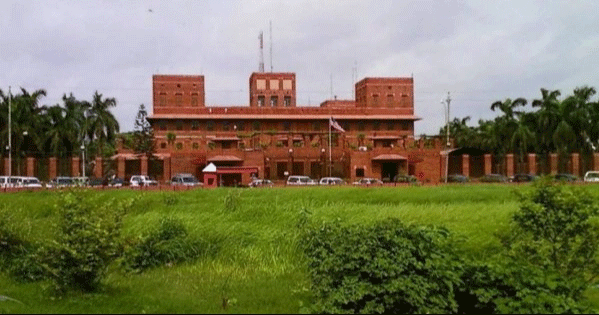Bangladesh land boundary to increase by 50,000 hectares
New char land to be added in main land
Special Correspondent: Seven to eight thousand hectares of chars are growing every year in the Bay of Bay of Bengal. In the next four to five years, Bhasanchar and Sandwip Char will be merged together. Bangladesh will get another 50,000 hectares of new land. This will help to increase the map of Bangladesh by expanding land boundary.
The distance from Bhasanchar in Noakhali to Sandwip in Chittagong is only four kilometers by boat. In this central place, new chars are rising with silt. In the next four to five years, Bhasanchar will connect Sandwip by land. The country will get 50 thousand hectares of new land. Extensive afforestation will be done to protect that land.
Satellite imagery shows that the water depth between Sandwip and Bhasanchar is one to two feet. But somewhere up to a depth of about 20 feet. Sandwip may merge with Bhasanchar in the next four to five years after filling these depths with new silt. The forest department then demanded that the connection between the two islands be established not by water but by road. There are many more submarines that are filled with silt and are expected to wake up in the next few years.
Sources in the forest department said that the government has a comprehensive afforestation plan so that the lands of these newly awakened chars are not submerged in water.
Every year seven to eight thousand hectares of chars are growing in the country. There are 56 international rivers in this riverine country. Sediment is accumulating in the estuary of Meghna through these rivers. On the one hand, new chars are emerging and on the other hand, many lands are being lost in rivers and seas due to various natural calamities. About 100 crore tons of sediment is falling in the Bay of Bengal every year through Brahmaputra, Meghna and Padma rivers. New chars are rising in this silt.
The highest number of chars are in Hatia of Noakhali, Bhasanchar and Sandwip of Chittagong. Huge afforestation is being done to sustain the soil of these awakened chars. As the amount of oxygen increases, so does the biodiversity.
Coastal Forest Conservator Mohammad Harun Or Rashid Khan told that a lot of silt from India enters Bangladesh through rivers. Seven to eight thousand hectares of chars are growing every year. In the next four to five years, Bhasanchar and Sandwip Char will be merged together. In this, Bangladesh will get another 50,000 hectares of new land. We have taken extensive afforestation initiatives to sustain these lands.
The project is being implemented in the coastal districts of Bagerhat, Pirojpur, Barguna, Bhola, Laxmipur, Noakhali and Cox’s Bazar. This initiative has been taken under the project ‘Afforestation of coastal areas including new chars in the Bay of Bengal’. The Forest Department has been implementing this project since January 2016. The project will be completed in December 2022.
The total cost of this afforestation project is Tk 104 crore 70 lakh 26 thousand. There are about 10 months left till the end of the project. However, the progress of the project in the last four years is only 55 percent. As a result, there is uncertainty about the completion of the rest of the work. However, the Forest Department has already said that the duration of the project will be extended for another year and a half (till June 2024).
Under this afforestation project, planting of saplings in 30,000 out of 40,000 houses is expected to be completed by the current financial year (2021-22). So far, saplings have been planted in 21 thousand 514 houses.
Besides increasing the project time, the total cost is also increasing to Tk 34 million. The project, which started in January 2016, was initially planned to be completed by December 2021. However, the duration of the project was extended to December 2022 to increase afforestation in the new char.
Under this project Sadar upazila of Patuakhali, Dumki, Galachipa, Kalapara, Mirzaganj and Rangabali, Sadar upazila of Barguna, Amtali, Bamna, Betagi, Patharghata and Taltoli; Mathbaria and Bhandaria of Pirojpur, Sadar Upazila of Bhola, Borhanuddin, Char Fashion, Daulatkhan, Lalmohan, Monpura, Tajumuddin; Noakhali’s Sadar Upazila, Begumganj, Chatkhil, Kompaniganj, Hatia, Senbagh, Subarnachar, Sonaimuri, Kabirhat and Laxmipur’s Sadar Upazila, Raipur, Ramganj, Ramgati and Kamalnagar.
Main activities of the project
Creation of 25,000 hectares of mangrove gardens, creation of one thousand kilometers of strip gardens, afforestation of 40,000 homes, training of 5,000 beneficiaries on social forestry and garden creation techniques and climate change adaptation.
Scope of afforestation increasing
As the duration of the project increases, so does the cost. The amount of newly awakened chars in the chest or estuary varies due to upazila-wise division. As a result, forestry will be done in Hatia, Subarnachar, Rangabali, Char Fashion, Tajumuddin and Sandwip instead of six upazilas including Companiganj, Ramgati, Teknaf, Sitakunda, Sonagazi and Mathbaria.
Besides, afforestation will be done in Feni Sadar, Chagalnaiya, Daganbhuiyan, Parashuram, Sonagazi, Anwara in Chittagong, Banshkhali, Sitakunda, Sandwip, Teknaf in Cox’s Bazar, Maheshkhali, Kutubdia and Pekua.
Project objectives and goals
Accelerate the process of awakening new chars, adapt to climate change and create green belts to prevent cyclones and tidal surges by reducing its negative effects. At the same time increasing the reserves of carbon to mitigate the effects of climate change and increasing the biodiversity of marine flora and fauna through the development of habitat and breeding facilities.
According to the land ministry, many people in the country are still landless. The ‘Char Development and Settlement’ project has been taken up to rehabilitate 6,000 landless poor families in the awakened chars. The project, which has been running since July 2019, will end in June this year (2022). Under this project, plot-to-plot survey of 4,300 acres of land has been completed and 180 landless families have been selected. These landless families will gradually find a place in the awakened chars.
The list of newly awakened chars in the last 100 years includes Nijhumdwip, Nolerchar and Caringchar on the Noakhali coast, Uri Char in the northwest of Sandwip upazila in Chittagong and Bhasanchar five kilometers to the west.
More than 16,000 Rohingya refugees have already been relocated from Cox’s Bazar under the Bhasanchar shelter project, which was started almost two decades ago. Ganguria Char with an area of 100 sq km has risen 1.5 km south of Bhasanchar. Those concerned hope that cultivation will start in this char in four-five years.
Dewan Mahbubur Rahman, director of the Char Development and Settlement Project-Bridging (CDSP-Bridging) project, told that new chars are constantly emerging. The government is undertaking various programs under various projects around these chars. One of them is the rehabilitation of landless families. Houses are being built in the new chars for that purpose.
President Joe Biden tests positive for COVID-19 while campaigning in Las Vegas, has ‘mild symptoms’
International Desk: President Joe Biden tested positive for COVID-19 while traveling Wedne…







